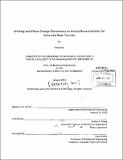| dc.contributor.advisor | Evelyn N. Wang. | en_US |
| dc.contributor.author | Xiao, Rong, Ph. D. Massachusetts Institute of Technology | en_US |
| dc.contributor.other | Massachusetts Institute of Technology. Department of Mechanical Engineering. | en_US |
| dc.date.accessioned | 2013-06-17T19:53:13Z | |
| dc.date.available | 2013-06-17T19:53:13Z | |
| dc.date.copyright | 2012 | en_US |
| dc.date.issued | 2013 | en_US |
| dc.identifier.uri | http://hdl.handle.net/1721.1/79285 | |
| dc.description | Thesis (Ph. D.)--Massachusetts Institute of Technology, Dept. of Mechanical Engineering, February 2013. | en_US |
| dc.description | Page 76 blank. Cataloged from PDF version of thesis. | en_US |
| dc.description | Includes bibliographical references (p. 71-75). | en_US |
| dc.description.abstract | Micro/nanostructures have been extensively studied to amplify the intrinsic wettability of materials to create superhydrophilic or superhydrophobic surfaces. Such extreme wetting properties can influence the heat transfer performance during phase-change which is of great importance in a wide range of applications including thermal management, building environment, water harvesting and power production. In particular, superhydrophilic surfaces have been of interest to achieve thin film evaporation with high heat fluxes. Meanwhile, superhydrophobic surfaces with dropwise condensation promises higher heat transfer coefficients than typical filmwise condensation. My thesis work aims at improving fundamental understanding as well as demonstrating practical enhancements in these two areas. A key challenge to realizing thin film evaporation is the ability to achieve efficient fluid transport using superhydrophilic surfaces. Accordingly, we developed a semi-analytical model based on the balance between capillary pressure and viscous resistance to predict the propagation rates in micropillar arrays with high aspect ratios. Our experimental results showed good agreement with the model, and design guidelines for optimal propagation rates were proposed. For micropillar arrays with low aspect ratio and large spacing between pillars, however, we identified that the microscopic sweeping of the liquid front becomes important. We studied this phenomenon, explained the effect of such microscale dynamics on the overall propagation behavior, and proposed a strategy to account for these dynamics. While these propagation studies provide a means to deliver liquid to high heat flux regions, we investigated a different configuration using nanoporous membrane that decouples capillarity from the viscous resistance to demonstrate the potential heat dissipation capability. With nanoporous membranes with average pore diameters of 150 nm and thicknesses of 50 [mu]m, we achieved interfacial heat fluxes as high as 96 W/cm2 via evaporation with isopropyl alcohol. The effect of membrane thickness was studied to offer designs that promise dissipation of 1000 W/cm 2 . Meanwhile, we developed new metrology to measure transient heat transfer coefficients with a temporal resolution of 0.2 seconds during the evaporation process. Such a technique offers insight into the relationship between liquid morphology and heat transfer behavior. Finally, for enhanced condensation, we demonstrated immersion condensation using a composite surface fabricated by infusing hydrophobic oil into micro/nanostructures with a heterogeneous coating. With this approach, three key attributes to maximize heat transfer coefficient, low departure radii, low contact angle, and high nucleation density, were achieved simultaneously. We specifically elucidated the mechanism for the increase in nucleation density and attribute it to the combined effect of reduced water-oil interfacial energy and local high surface energy sites. As a result, we demonstrated approximately 100% enhancement in heat transfer coefficient over state-of-the-art superhydrophobic surfaces with the presence of non-condensable gases. This thesis presents improved fundamental understanding of wetting, evaporation, and condensation processes on micro/nanostructures as well as practical implementation of these structures for enhanced heat transfer. The insights gained demonstrate the potential of new nanostructure engineering approaches to improve the performance of various thermal management and energy production applications. | en_US |
| dc.description.statementofresponsibility | by Rong Xiao. | en_US |
| dc.format.extent | [vii], 76 p. | en_US |
| dc.language.iso | eng | en_US |
| dc.publisher | Massachusetts Institute of Technology | en_US |
| dc.rights | M.I.T. theses are protected by
copyright. They may be viewed from this source for any purpose, but
reproduction or distribution in any format is prohibited without written
permission. See provided URL for inquiries about permission. | en_US |
| dc.rights.uri | http://dspace.mit.edu/handle/1721.1/7582 | en_US |
| dc.subject | Mechanical Engineering. | en_US |
| dc.title | Wetting and phase-change phenomena on micro/nanostructures for enhanced heat transfer | en_US |
| dc.type | Thesis | en_US |
| dc.description.degree | Ph.D. | en_US |
| dc.contributor.department | Massachusetts Institute of Technology. Department of Mechanical Engineering | |
| dc.identifier.oclc | 846904912 | en_US |
